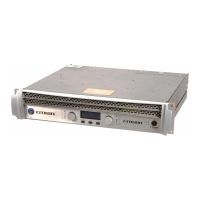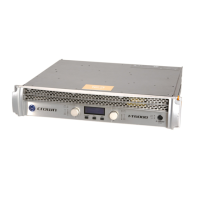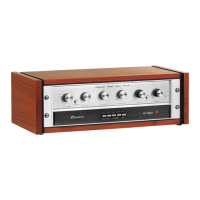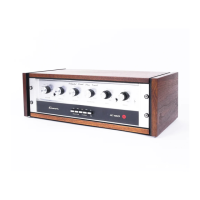Operation Manual
I-Tech Series Power Amplifiers
page 22
4.3 Presets
4.3.1 Introduction
Your I-Tech amplifier has a wide variety of onboard Digital Signal Process-
ing (DSP). Some applications for this DSP are speaker configuration (set-
ting the drive levels, frequency bands, delays and limiting for your
particular speakers), EQ, filtering, compression, and much more. Those
functions are described in Section 4.6. IQwic software lets you adjust the
DSP settings, such as filter slope, compression ratio, EQ frequency bands,
and so on.
A preset is a group of DSP settings that configure the amp for a specific
application. For example, you might use one preset that optimizes the
amp’s DSP for a JBL Vertec Line Array. You might use another preset that
sets up the DSP for a stereo pair of loudspeakers of your choice. You can
choose any of 20 presets with the LCD Control Screen.
The I-Tech amplifier works with two types of presets:
1. User presets. Using IQwic, you can create your own custom DSP pre-
sets, label them, and send them to the I-Tech amplifier. The amp stores
those presets in firmware. You can recall those presets from the LCD Con-
trol Screen.
2. Downloadable presets. Crown and JBL engineers have designed
presets that are optimized for various JBL loudspeakers, such as Vertec
Line Arrays. You can download presets from the Crown Support Forum at
http://www.crownaudio.com/forums/. Then in IQwic, send the preset files
to the I-Tech amplifier, where you can recall them from the LCD Control
Screen.
We will describe each type of preset in detail.
4.3.2 User Presets
User presets are DSP presets that you set up. This is the basic procedure:
1. Adjust the DSP settings as desired in the IQwic software (not with the
LCD Control Screen).
2. Save this group of settings as preset. Give it a label.
3. Download the preset to the I-Tech amplifier. See the Presets Help file in
IQwic for details. Basically, you will open and engage a data frame.
4. Select that preset from the LCD Control Screen. The preset will automat-
ically set the DSP parameters as you set them up in IQwic.
Setting the parameters of the DSP in the I-Tech amplifier is done using the
IQwic software, not by the amplifier’s LCD Control Screen. For example, if
you want to set filter Q, compression ratio, or graphic EQ, you would do so
within the IQwic software.
Adjusting DSP parameters within IQwic can be done in two ways: with a
software Wizard or directly. The Wizard asks a series of questions to help
you set up DSP parameters for loudspeakers.
If you need to do more advanced control than the Wizard offers, you can set
the parameters directly. If you need assistance, in IQwic select Help, then
select Adjusting DSP.
After setting the DSP parameters as desired,
1. Save them as a preset in IQwic. Presets are stored and recalled through
the Presets Page in IQwic. See the Presets Help file in IQwic for details.
2. Download the preset to the I-Tech amplifier. See the Presets Help file in
IQwic for details. Basically, you will open and engage a data frame.
3. When you want to recall the preset, select it on the LCD Control Screen.
4.3.3 Downloadable Presets
Crown and JBL engineers have designed I-Tech DSP presets that are opti-
mized for various JBL loudspeakers, such as Vertec Line Arrays. To use
them, follow this procedure:
1. Go to the I-Tech website at www.crownaudio.com/itech/.
2. Select Downloads.
3. Click on the preset of your choice. It will download to your computer.
4. In IQwic, select File > Open. Browse to the downloaded preset file and
open it.
5. In IQwic, see the Help file on Presets for details on downloading the pre-
set to an I-Tech amplifier. Basically, you will open and engage a data frame.
The file will overwrite the preset you designate.
6. Recall the preset from the LCD Control Screen. Then your amp will be
configured to work with the specified loudspeaker model.
4.4 Digital Audio Options (AES/EBU)
Digital audio inputs allow you to keep the amplifier input signals in the
digital domain. Keeping the input signal digital reduces the number of Dig-
ital-to-Analog and Analog-to-Digital conversions. This provides better
sound quality and reduces pickup of electrical interference.
The AES/EBU connector provides the most widely accepted format. Con-
nect an AES/EBU signal to the AES/EBU connector on the rear panel.
4 Advanced Operation
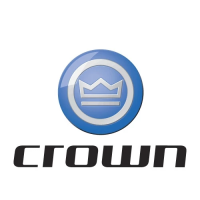
